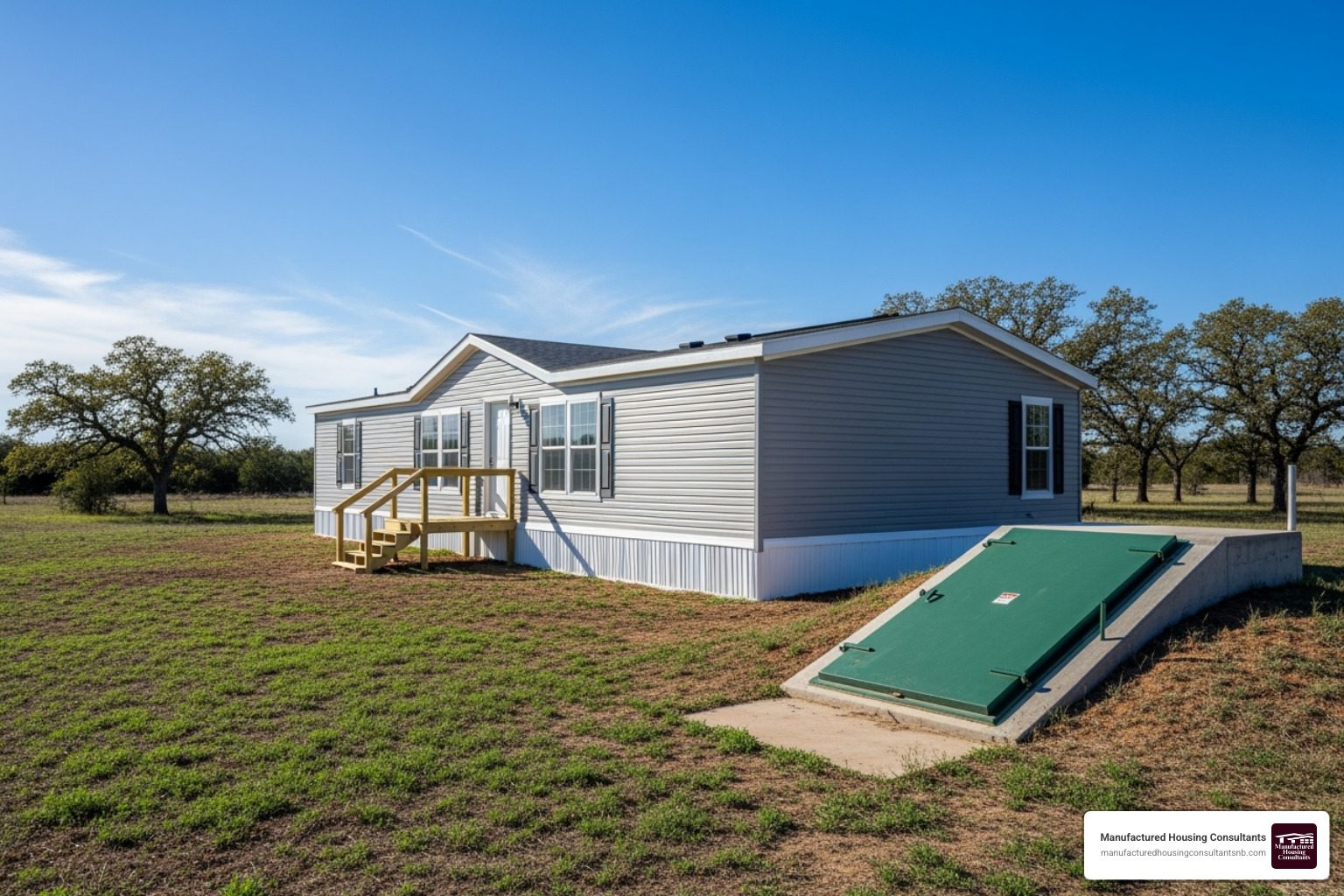Finding Your Safe Haven: The Best Storm Shelters for Mobile Homes
Don't risk it! Find your ideal storm shelter mobile home. Explore types, installation, costs to protect your Texas home.
Why Storm Shelter Mobile Home Protection is Critical in Texas
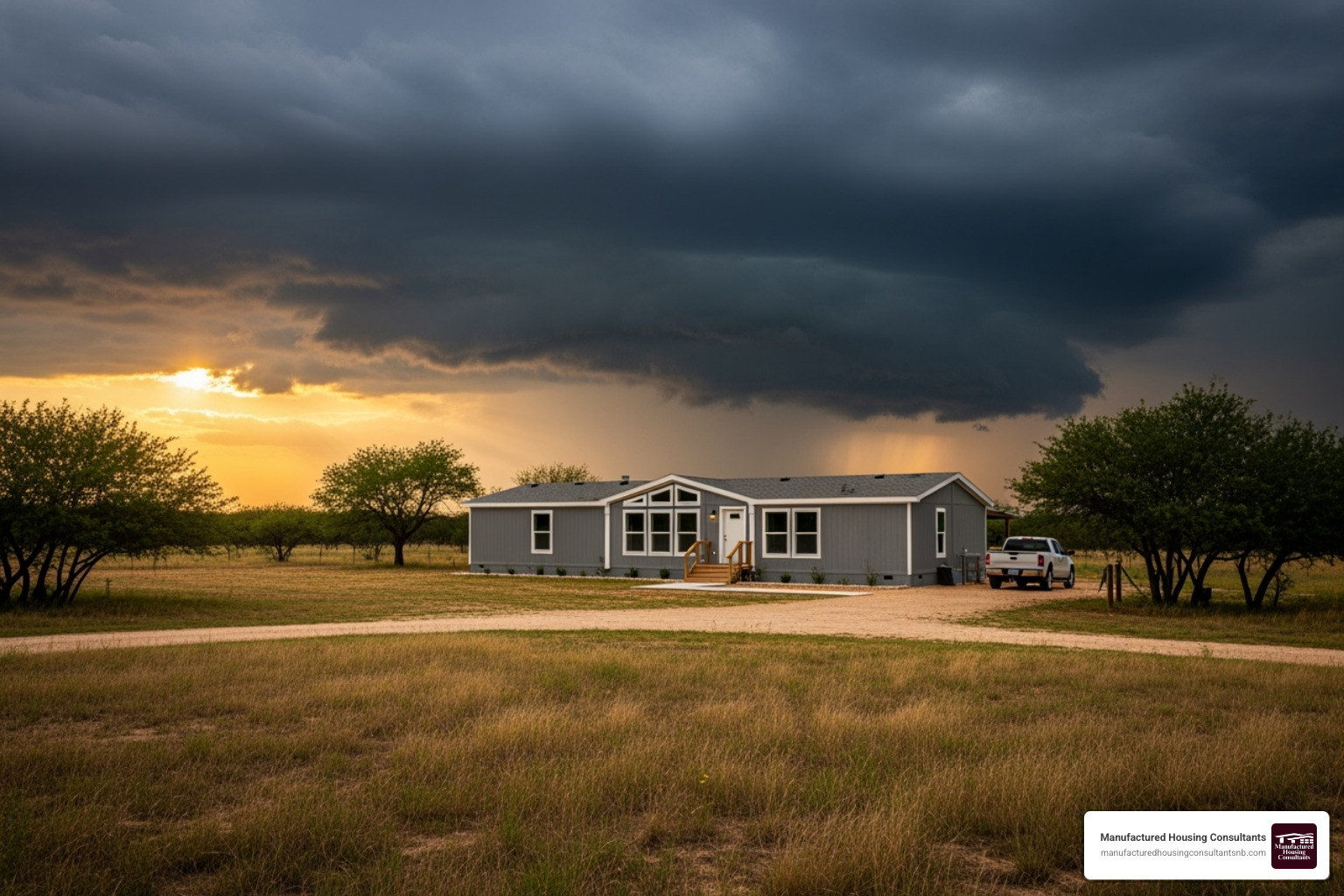
For Texans living in manufactured homes, a storm shelter mobile home solution is a life-saving necessity. Located in Tornado Alley with coastal hurricane risks, Texas weather can be severe. The statistics are sobering: residents of manufactured homes are 15-20 times more likely to be killed in a tornado than those in permanent homes. While these homes represent only 6% of the U.S. housing stock, they account for 54% of tornado housing fatalities.
No manufactured home, regardless of how well it’s built or tied down, can withstand a direct hit from a major tornado. At Manufactured Housing Consultants in New Braunfels, we know that making a plan for severe weather is a critical investment in your family’s safety. Fortunately, you have several effective options:
- Above-Ground Safe Rooms: Steel shelters anchored to a concrete slab.
- Underground Bunkers: Below-ground shelters offering maximum protection.
- Community Shelters: Shared facilities in mobile home parks or public buildings.
Whether you own your land or live in a community, a certified storm shelter provides the protection your home cannot. It’s about having peace of mind when the skies turn dark.
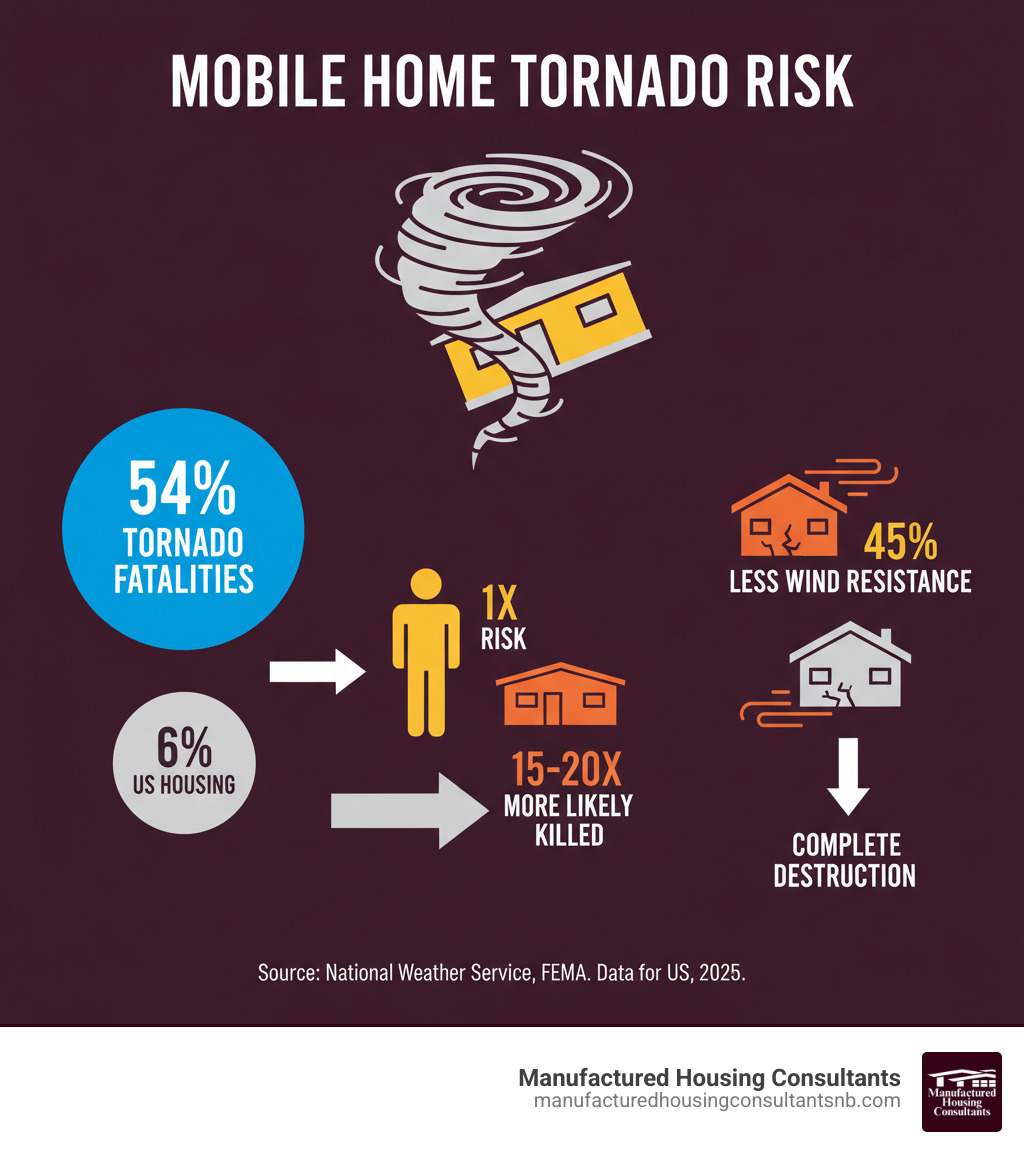
Why Mobile Homes Need Special Protection & Available Shelter Types
Living in a manufactured home in Texas offers incredible value, but it’s crucial to understand the risks posed by severe weather. At Manufactured Housing Consultants, we want to be honest about why your home isn’t a safe place during a tornado and what real protection looks like.
The Unseen Dangers: Mobile Home Vulnerability in Texas Storms
Manufactured homes are not designed to be storm shelters. Their vulnerability stems from a few key factors:
- Lightweight Construction: Built to be transportable, these homes are lighter than site-built structures, making them more susceptible to high winds.
- Aerodynamic Lift: The shape of a manufactured home can act like an airplane wing in powerful winds, creating lift even when properly tied down.
- Tie-Down Limitations: While essential for stability, tie-downs are not engineered to withstand the catastrophic forces of an EF-3 or stronger tornado.
- Flying Debris: During a storm, debris becomes deadly projectiles. The materials used in manufactured homes offer less protection against high-speed impacts than heavier, site-built homes.
The statistics from FEMA confirm the risk: residents are 15-20 times more likely to be killed during a tornado. In Texas, with its dual threat of tornadoes and hurricanes, having a storm shelter mobile home plan is not optional—it’s essential for survival.
Above-Ground vs. Underground Shelters
When investing in a shelter, your main choice is between an above-ground safe room and an underground bunker. Both provide life-saving protection that your home cannot.
Above-ground safe rooms are reinforced steel structures anchored to a concrete slab. Their primary advantage is accessibility, as they don’t require stairs, making them ideal for individuals with mobility issues or families with small children. Installation is also simpler and less expensive, especially in Texas areas with rocky soil or high water tables where an underground shelter would be impractical. Costs typically range from $3,000 to $8,000.
Underground bunkers offer the ultimate protection by using the earth as a natural shield against wind and debris. However, they present challenges. The required stairs or ladder can be a barrier for some, and Texas’s high water table can create a flooding risk. Excavation in rocky soil can be difficult and costly, with prices generally starting at $5,000 and reaching $15,000 or more.
| Feature | Above-Ground Shelters | Underground Shelters |
|---|---|---|
| Cost | $3,000 – $8,000 (installed) | $5,000 – $15,000+ (installed) |
| Accessibility | Excellent – no stairs, often wheelchair accessible | Poor – requires stairs/ladder |
| Installation | Easier, less excavation, faster | Complex, significant excavation required |
| Space Requirements | Requires exterior footprint near home | Occupies underground space |
| Texas Soil Suitability | Works in all soil types and water table conditions | Challenging with high water tables or rocky soil |
Community Shelters and Other Safety Plans
If a personal shelter isn’t feasible, you still have options. Many mobile home communities provide central storm shelters for residents. Additionally, most Texas counties designate public shelters in sturdy buildings like schools or community centers. The key is to identify your nearest shelter before a storm is approaching.
The most important step is to have an emergency plan. At Manufactured Housing Consultants, we urge every client to create one. Know where you will go—a community shelter, a public facility, or a friend’s site-built home with a basement. Practice the route and know how long it takes to get there.
Stay informed by investing in a NOAA Weather Radio and signing up for local severe weather alerts. Keep NOAA weather alerts bookmarked. When a tornado watch is issued, prepare to act. When a warning is issued, execute your plan immediately.

As a last resort if you cannot reach a shelter, lie flat in a ditch or low-lying area, covering your head with your arms. The goal is to get below the path of flying debris. Your manufactured home is a wonderful place to live, but it is not a safe place to be during a tornado.
A Practical Guide to Installing a Storm Shelter for Your Mobile Home
Deciding to install a storm shelter mobile home solution is a smart move. Now, let’s cover the practical steps: ensuring your shelter meets safety standards, choosing the right location, and understanding the costs and maintenance involved.
Key Standards for a Safe Storm Shelter Mobile Home
Not all storm shelters are created equal. To ensure you’re buying real protection, look for shelters that meet or exceed established safety standards. A reputable shelter should be certified to prove it can withstand extreme weather.
Key certifications and standards to look for include:
- FEMA P-361 & ICC 500: These are the gold standards for shelter design and construction. FEMA P-361 provides guidelines for “near-absolute protection,” while ICC 500 is the consensus-based standard written into building codes.
- NSSA or ATSA Membership: Membership in the National Storm Shelter Association (NSSA) or certification from the American Tornado Shelter Association (ATSA) indicates the manufacturer adheres to strict quality and safety protocols.
- EF-5 Tornado Rating & Debris Impact Testing: This certification proves the shelter has been physically tested—often at facilities like Texas Tech University’s National Wind Institute—to withstand 250 mph winds and impacts from flying debris, like a 2×4 plank traveling at high speed.
These standards ensure the shelter has critical features like heavy-gauge steel construction, a reinforced door with a secure locking system, and proper ventilation.
Installation, Location, and Foundation Requirements for a Storm Shelter Mobile Home
Once you’ve chosen a certified shelter, proper installation is key to its effectiveness.
Location is critical. Place the shelter as close to your home as possible for quick access during a warning, but ensure the path is always clear. Avoid placing it in the “fall radius” of large trees that could topple onto it during a storm.
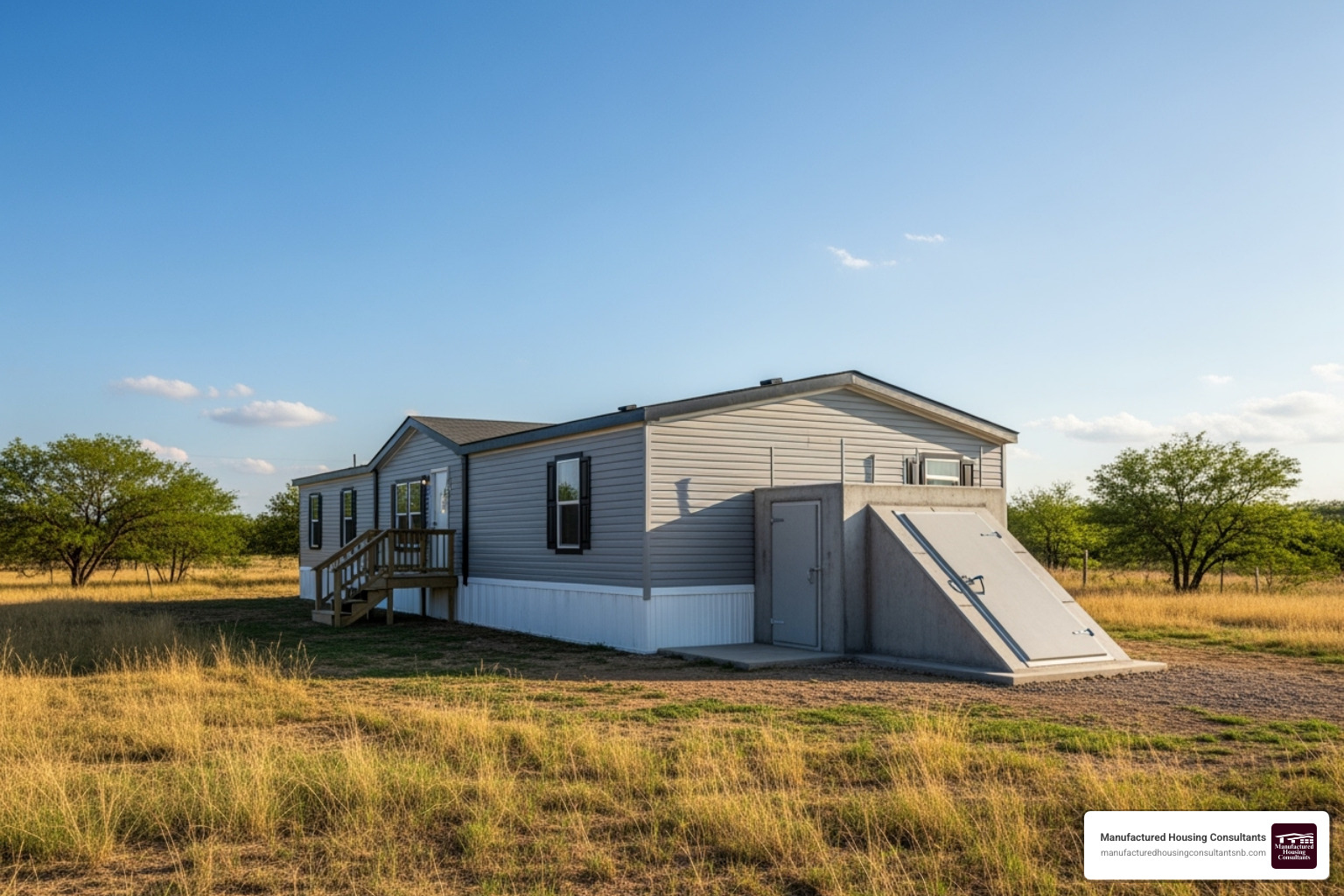
The foundation is the most important part of the installation. An above-ground storm shelter mobile home must be anchored to its own dedicated, reinforced concrete slab. This is not a standard patio slab; it must be at least 4 inches thick and reinforced with rebar or post-tension cables. The shelter is then bolted to this foundation with high-wind-rated anchors.
Crucially, never anchor a storm shelter to your mobile home’s floor or frame. Your home is not designed to act as an anchor. The shelter needs an independent foundation to remain secure.
Before starting, check with your local Texas municipality for building codes and permits. If you live in a mobile home park, review their rules for external structures. At Manufactured Housing Consultants, we provide expert mobile home foundation installation and can help you steer these requirements. Understanding the different types of mobile home foundations highlights why a dedicated shelter foundation is so vital.
Costs, Maintenance, and Your Emergency Plan
Investing in a storm shelter is an investment in your family’s life. Here’s a breakdown of what to expect.
Costs for an above-ground safe room typically range from $3,000 to $8,000, plus installation and the cost of the concrete slab. Underground bunkers are more expensive, from $5,000 to over $15,000. Look into FEMA grants and local rebate programs, which can help offset the cost. Manufactured Housing Consultants also offers financing options to make these life-saving investments more accessible.
While a DIY safe room might seem cheaper, it’s risky unless you have expert construction knowledge and strictly follow FEMA guidelines. A professionally installed, certified shelter is the safest bet.
Regular maintenance is simple but important. Periodically inspect your shelter for rust or cracks, check that the door and locks function smoothly, and ensure vents are clear. For underground shelters, check for any signs of leaks.
Finally, stock your shelter with an emergency kit. Keep it ready with essentials like:
- Water and non-perishable food (3-day supply)
- Flashlight and extra batteries
- First-aid kit and necessary medications
- Battery-powered or hand-crank radio
- Whistle, dust masks, and sturdy shoes
- Copies of important documents
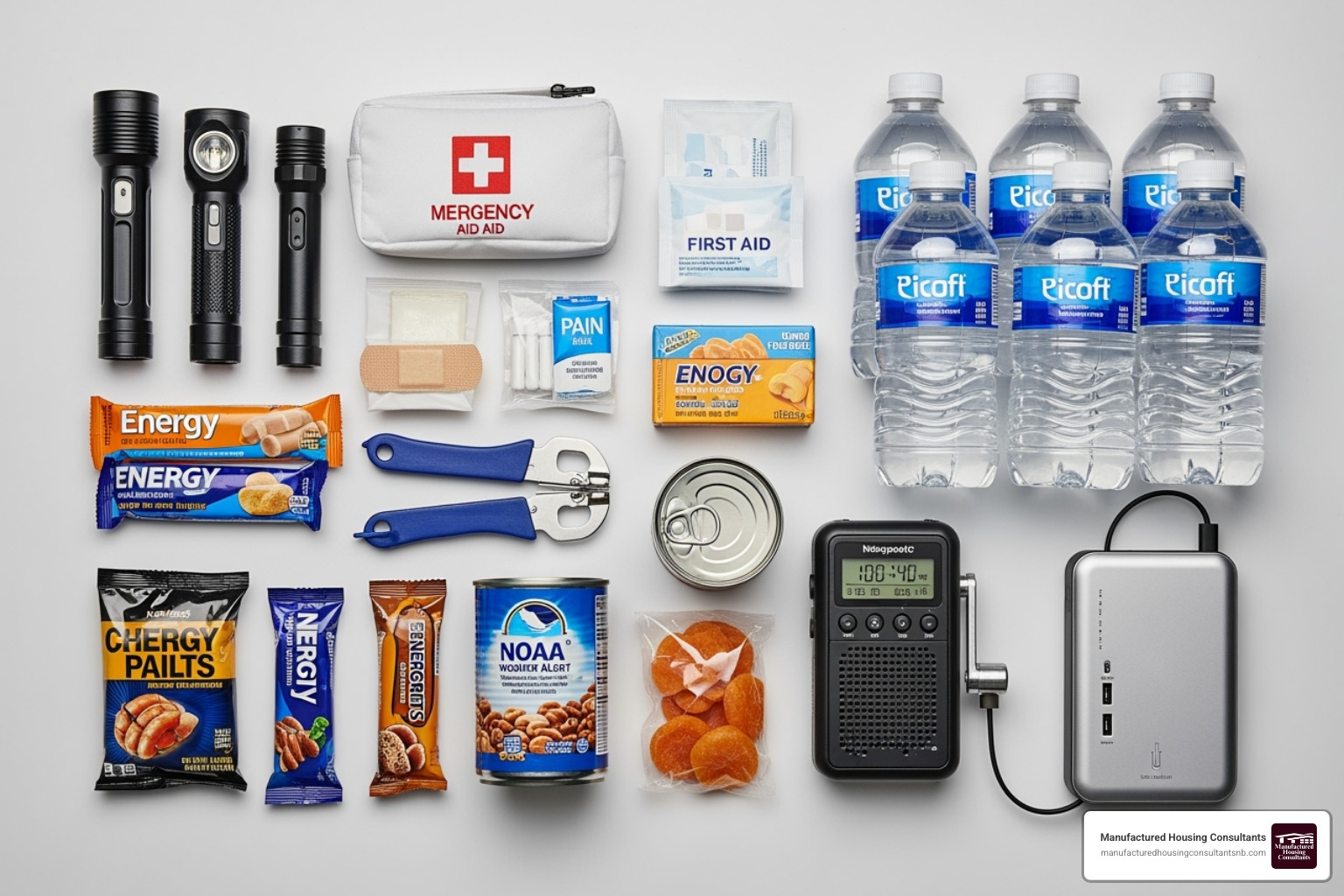
At Manufactured Housing Consultants in New Braunfels, we are committed to your safety. With our deep expertise in Texas weather and manufactured homes, we can help you prepare. If you’re considering a storm shelter or need help with site preparation, we’re here for you. Contact us for foundation and site prep services and let’s build a safer future for your family.

